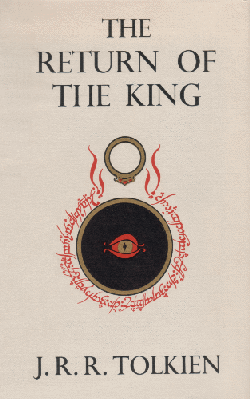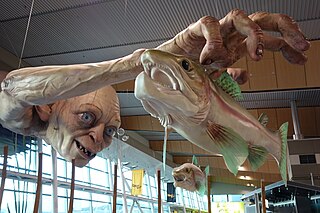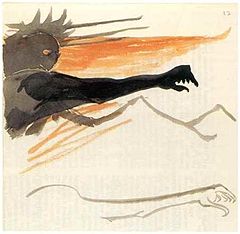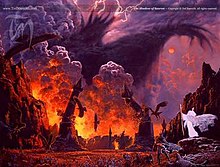
The Lord of the Rings is an epic high fantasy novel by the English author and scholar J. R. R. Tolkien. Set in Middle-earth, the story began as a sequel to Tolkien's 1937 children's book The Hobbit, but eventually developed into a much larger work. Written in stages between 1937 and 1949, The Lord of the Rings is one of the best-selling books ever written, with over 150 million copies sold.
The Nazgûl, introduced as Black Riders and also called Ringwraiths, Dark Riders, the Nine Riders, or simply the Nine, are fictional characters in J. R. R. Tolkien's Middle-earth. They were nine Men who had succumbed to Sauron's power through wearing Rings of Power, which gave them immortality but reduced them to invisible wraiths, servants bound to the power of the One Ring and completely under Sauron's control.
Samwise Gamgee is a fictional character in J. R. R. Tolkien's Middle-earth. A hobbit, Samwise is the chief supporting character of The Lord of the Rings, serving as the loyal companion of the protagonist Frodo Baggins. Sam is a member of the Fellowship of the Ring, the group of nine charged with destroying the One Ring to prevent the Dark Lord Sauron from taking over the world.
Shelob is a fictional monster in the form of a giant spider from J. R. R. Tolkien's The Lord of the Rings. Her lair lies in Cirith Ungol leading into Mordor. The creature Gollum deliberately leads the Hobbit protagonist Frodo there in hopes of recovering the One Ring by letting Shelob attack Frodo. The plan is foiled when Samwise Gamgee temporarily blinds Shelob with the Phial of Galadriel, and then severely wounds her with Frodo's Elvish sword, Sting.
The Rings of Power are magical artefacts in J. R. R. Tolkien's legendarium, most prominently in his high fantasy novel The Lord of the Rings. The One Ring first appeared as a plot device, a magic ring in Tolkien's children's fantasy novel, The Hobbit; Tolkien later gave it a backstory and much greater power. He added nineteen other Great Rings, also conferring powers such as invisibility, that it could control, including the Three Rings of the Elves, Seven Rings for the Dwarves, and Nine for Men. He stated that there were in addition many lesser rings with minor powers. A key story element in The Lord of the Rings is the addictive power of the One Ring, made secretly by the Dark Lord Sauron; the Nine Rings enslave their bearers as the Nazgûl (Ringwraiths), Sauron's most deadly servants.

The Two Towers is the second volume of J. R. R. Tolkien's high fantasy novel The Lord of the Rings. It is preceded by The Fellowship of the Ring and followed by The Return of the King. The volume's title is ambiguous, as five towers are named in the narrative, and Tolkien himself gave conflicting identifications of the two towers. The narrative is interlaced, allowing Tolkien to build in suspense and surprise. The volume was largely welcomed by critics, who found it exciting and compelling, combining epic narrative with heroic romance.

The Return of the King is the third and final volume of J. R. R. Tolkien's The Lord of the Rings, following The Fellowship of the Ring and The Two Towers. It was published in 1955. The story begins in the kingdom of Gondor, which is soon to be attacked by the Dark Lord Sauron.

The Return of the King is a 1980 animated musical fantasy television film created by Rankin/Bass and Topcraft. It is an adaptation of part of J. R. R. Tolkien 1955 high fantasy novel The Lord of the Rings. It takes its name from The Return of the King, the third and final volume of the novel, and is a sequel to the 1977 film The Hobbit.
In J. R. R. Tolkien's epic fantasy novel The Lord of the Rings, the Battle of the Morannon or the Battle of the Black Gate, is the final confrontation in the War of the Ring. Gondor and its allies send a small army ostensibly to challenge Sauron at the entrance to his land of Mordor; he supposes that they have with them the One Ring and mean to use it to defeat him. In fact, the Ring is being carried by the hobbits Frodo Baggins and Sam Gamgee into Mordor to destroy it in Mount Doom, and the army is moving to distract Sauron from them. Before the battle, a nameless leader, the "Mouth of Sauron", taunts the leaders of the army with the personal effects of Frodo and Sam. Battle is joined, but just as it seems the army of Gondor will be overwhelmed, the Ring is destroyed, and the forces of Sauron lose heart. Mount Doom erupts, and Sauron's tower, Barad-dûr, collapses, along with the Black Gate. The army of Gondor returns home victorious, the War of the Ring won.
Scholars and critics have identified many themes of The Lord of the Rings, a major fantasy novel by J. R. R. Tolkien, including a reversed quest, the struggle of good and evil, death and immortality, fate and free will, the danger of power, and various aspects of Christianity such as the presence of three Christ figures, for prophet, priest, and king, as well as elements like hope and redemptive suffering. There is also a strong thread throughout the work of language, its sound, and its relationship to peoples and places, along with moralisation from descriptions of landscape. Out of these, Tolkien stated that the central theme is death and immortality.
"The Council of Elrond" is the second chapter of Book 2 of J. R. R. Tolkien's bestselling fantasy work, The Lord of the Rings, which was published in 1954–1955. It is the longest chapter in that book at some 15,000 words, and critical for explaining the power and threat of the One Ring, for introducing the final members of the Fellowship of the Ring, and for defining the planned quest to destroy it. Contrary to the maxim "Show, don't tell", the chapter consists mainly of people talking; the action is, as in an earlier chapter "The Shadow of the Past", narrated, largely by the Wizard Gandalf, in flashback. The chapter parallels the far simpler Beorn chapter in The Hobbit, which similarly presents a culture-clash of modern with ancient. The Tolkien scholar Tom Shippey calls the chapter "a largely unappreciated tour de force". The Episcopal priest Fleming Rutledge writes that the chapter brings the hidden narrative of Christianity in The Lord of the Rings close to the surface.

Gollum is a fictional character in J. R. R. Tolkien's Middle-earth legendarium. He was introduced in the 1937 fantasy novel The Hobbit, and became important in its sequel, The Lord of the Rings. Gollum was a Stoor Hobbit of the River-folk who lived near the Gladden Fields. In The Lord of the Rings it is stated that he was originally known as Sméagol, corrupted by the One Ring, and later named Gollum after his habit of making "a horrible swallowing noise in his throat".
Aragorn is a fictional character and a protagonist in J. R. R. Tolkien's The Lord of the Rings. Aragorn was a Ranger of the North, first introduced with the name Strider and later revealed to be the heir of Isildur, an ancient King of Arnor and Gondor. Aragorn was a confidant of the wizard Gandalf, and played a part in the quest to destroy the One Ring and defeat the Dark Lord Sauron. As a young man, Aragorn fell in love with the immortal elf Arwen, as told in "The Tale of Aragorn and Arwen". Arwen's father, Elrond Half-elven, forbade them to marry unless Aragorn became King of both Arnor and Gondor.
Frodo Baggins is a fictional character in J. R. R. Tolkien's writings, and one of the protagonists in The Lord of the Rings. Frodo is a hobbit of the Shire who inherits the One Ring from his cousin Bilbo Baggins, described familiarly as "uncle", and undertakes the quest to destroy it in the fires of Mount Doom in Mordor. He is mentioned in Tolkien's posthumously published works, The Silmarillion and Unfinished Tales.

In J. R. R. Tolkien's fictional world of Middle-earth, Mordor is the realm and base of the evil Sauron. It lay to the east of Gondor and the great river Anduin, and to the south of Mirkwood. Mount Doom, a volcano in Mordor, was the goal of the Fellowship of the Ring in the quest to destroy the One Ring. Mordor was surrounded by three mountain ranges, to the north, the west, and the south. These both protected the land from invasion and kept those living in Mordor from escaping.

The One Ring, also called the Ruling Ring and Isildur's Bane, is a central plot element in J. R. R. Tolkien's The Lord of the Rings (1954–55). It first appeared in the earlier story The Hobbit (1937) as a magic ring that grants the wearer invisibility. Tolkien changed it into a malevolent Ring of Power and re-wrote parts of The Hobbit to fit in with the expanded narrative. The Lord of the Rings describes the hobbit Frodo Baggins's quest to destroy the Ring.

Sauron is the title character and the primary antagonist, through the forging of the One Ring, of J. R. R. Tolkien's The Lord of the Rings, where he rules the land of Mordor and has the ambition of ruling the whole of Middle-earth. In the same work, he is identified as the "Necromancer" of Tolkien's earlier novel The Hobbit. The Silmarillion describes him as the chief lieutenant of the first Dark Lord, Morgoth. Tolkien noted that the Ainur, the "angelic" powers of his constructed myth, "were capable of many degrees of error and failing", but by far the worst was "the absolute Satanic rebellion and evil of Morgoth and his satellite Sauron". Sauron appears most often as "the Eye", as if disembodied.
Character pairing in The Lord of the Rings is a literary device used by J. R. R. Tolkien, a Roman Catholic, to express some of the moral complexity of his major characters in his heroic romance, The Lord of the Rings. Commentators have noted that the format of a fantasy does not lend itself to subtlety of characterisation, but that pairing allows inner tensions to be expressed as linked opposites, including, in a psychoanalytic interpretation, those of Jungian archetypes.
"The Shadow of the Past" is the second chapter of J. R. R. Tolkien's bestselling fantasy work, The Lord of the Rings, which was published in 1954–1955. Tolkien called it "the crucial chapter"; the Tolkien scholar Tom Shippey labelled it "the vital chapter". This is because it represents both the moment that Tolkien devised the central plot of the book, and the point in the story where the protagonist, Frodo Baggins, and the reader realise that there will be a quest to destroy the Ring. A sketch of it was among the first parts of the book to be written, early in 1938; later that year, it was one of three chapters of the book that he drafted. In 1944, he returned to the chapter, adding descriptions of Gollum, the Ring, and the hunt for Gollum.
The theme of addiction to power in The Lord of the Rings is central, as the Ring, made by the Dark Lord Sauron to enable him to take over the whole of Middle-earth, progressively corrupts the mind of its owner to use the Ring for evil.









